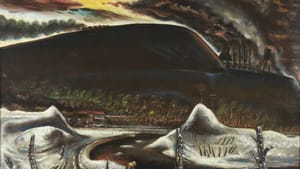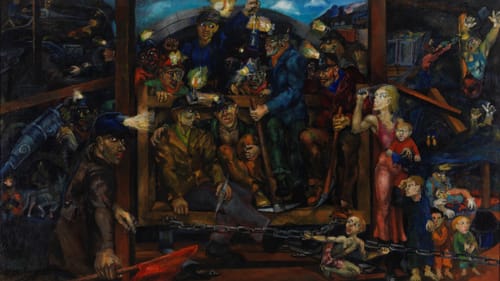Stay in the Loop
BSR publishes on a weekly schedule, with an email newsletter every Wednesday and Thursday morning. There’s no paywall, and subscribing is always free.
The world’s oldest mountains get a gallery at last
PAFA presents Layers of Liberty: Philadelphia and the Appalachian Environment

Lately, museums have been exploring our complicated, often rapacious relationship with the natural world. DC’s National Portrait Gallery is currently showing Forces of Nature: Voices that Shaped Environmentalism, and last year the Brandywine Museum of Art mounted an exhibition titled Fragile Earth. Mirroring this trend in ecocritical scholarship, PAFA’s current offering is the deeply researched Layers of Liberty: Philadelphia and the Appalachian Environment.
Curated by West Virginia native Ali Printz, PAFA’s Terra Foundation Curatorial Fellow, the exhibition was motivated by a dearth of Appalachian art in museums, noteworthy since nearly 70 percent of Pennsylvania lies in this vast region encompassing 13 states. On view here are works by 41 artists that examine the ecology of early America and the transportation network created by and contributing to the use, misuse, and commodification of the region’s abundant resources.
Layers of Liberty is in the museum’s expansive second-floor Annenberg Gallery, with works chronologically lining stark white walls. The large box-like gallery has no seating, and there is nothing visually striking about the overall installation. In fact, it’s somewhat daunting to see these 56 artworks stretching out before you. But once you enter and look closely, the exhibition’s historical, geographic, and artistic discoveries ameliorate its initial starkness.
Land grabs, coal, and timber
It opens with a series of compositional studies (cartoons) for Penn’s Treaty with the Indians (1711) by Benjamin West (1738-1820), the famous work reprinted in many history textbooks. That large painting is not here, but West’s preliminary sketches of ink and Chinese white on brown paper render the work totally recognizable and the artist’s hand (even after three centuries) immediate and present. Wall text notes that Penn’s land-grab from the Lenape people set in motion land-rights issues that continue to this day, and these drawings set the tone for what follows: a roomful of relatively unfamiliar works, often by relatively unknown artists, that explore the all-too-familiar rapaciousness of our country’s westward expansion.
The next paintings you encounter are two large landscapes by unfamiliar but accomplished artists that further the exhibition’s theme. Conestoga Creek and Lancaster (1833) by Philadelphian Jacob Eichholtz (1776-1842) romantically depicts the waterways transporting coal statewide, and Mahoney Mountain on the Susquehanna River (1840) by Pittsburgh-born Russell Smith (1812-1896) shows an explorer leaning on his rifle and dwarfed by the immensity of the Appalachians.
Both coal and timber were taken from the region, and two striking woodcuts by Rockwell Kent (1882-1971) illustrate the importance of railroads. The renowned Kent worked well into the 20th century, and his Two Locomotives and Train Tunnel were part of an industrial print series (1929-30) that also credits his gifted printer Julius J. Lankes (1884-1960).
Heat and danger, disaster and spring
Another print series by PAFA artist Catherine E. Dallett (1860-1956) depicts the Lehigh Canal that took coal from northeastern Pennsylvania into Philadelphia. And there are six fascinating drawings by Herbert Pullinger (1878-1961) of slate quarries, coal mines, steel mills, and blast furnaces, drawn with red litho crayon that subliminally adds heat and danger to his depiction of these industrial locales. There are two watercolors by this prolific Philadelphia artist (in the collections of both PAFA and the Philadelphia Museum of Art), part of a series called The Mines, Mount Pleasant Breaker, Scranton (1912-1919).

Mine Disaster (1933-37) is a riveting work by painter Philip Evergood (1901-1973), a triptych whose three sections (all on the same canvas) are titled Labor in Darkness, Rescue Squad, and Tragedy of Entombment. The large oil’s impact is reminiscent of Picasso’s Guernica, another tragic depiction. Evergood was a student of the better-known artist and teacher George Luks, whose works are also featured here.
Spring in the Coal Regions (1944) by Hubert Davis (1902-1977) shows a train transporting coal along a polluted river while black smoke pours into the sky. WPA artist Davis was born in Milton, Pennsylvania, and studied in Philadelphia, New York City, and Paris. And there is a surprising untitled piece by Franz Kline (1910-1962), the Abstract Expressionist master who was born in the anthracite coal fields of Wilkes-Barre. Though the work (oil, ink, and collage) was clearly influenced by Japanese calligraphy, it also references a childhood spent in the darkness of the coal mining culture.
The world’s oldest mountains
The exhibition’s final section shows more pastoral views of the region by painters like Charles Burchfield (1893-1967), Alfred Leslie (1927-2023), and Neil G. Welliver (1929-2005), among others. Though more colorful and visually engaging, these newer works are the least informative and feel somewhat tenuously connected thematically with the exhibition’s earlier, more impactful works.
As well as a look at artists we may not know, Layers of Liberty is also a cautionary lesson in regional history and geography, filled with original scholarship and new information. Wall labels are in English and Spanish, but the straight-on lighting and font and color choices, though visually striking, often render the text difficult to read.
The Appalachians, still a haven for biodiversity, are the oldest mountain range in the world. Once canals were constructed and train lines established, a 19th-century “coal rush” stripped the land of many of its natural resources. In 1865 alone, 11 million tons of coal were taken from the region. Though not at first warmly inviting, Layers of Liberty is well worth a close look. It amply details how artists have been instrumental in illustrating the ways that we have both used and abused this pivotal American region.
What, When, Where
Layers of Liberty: Philadelphia and the Appalachian Environment. $7-$15 (free for kids under 12). Through November 3, 2024, at the Pennsylvania Academy of the Fine Arts's Samuel M. Hamilton Building, Annenberg Gallery, 128 North Broad Street, Philadelphia. (215) 972-7600 or pafa.org.
Accessibility
The Hamilton Building and all facilities are wheelchair-accessible. Wheelchairs are available, service animals are welcome, and personal care attendants are admitted free.
Sign up for our newsletter
All of the week's new articles, all in one place. Sign up for the free weekly BSR newsletters, and don't miss a conversation.

 Gail Obenreder
Gail Obenreder